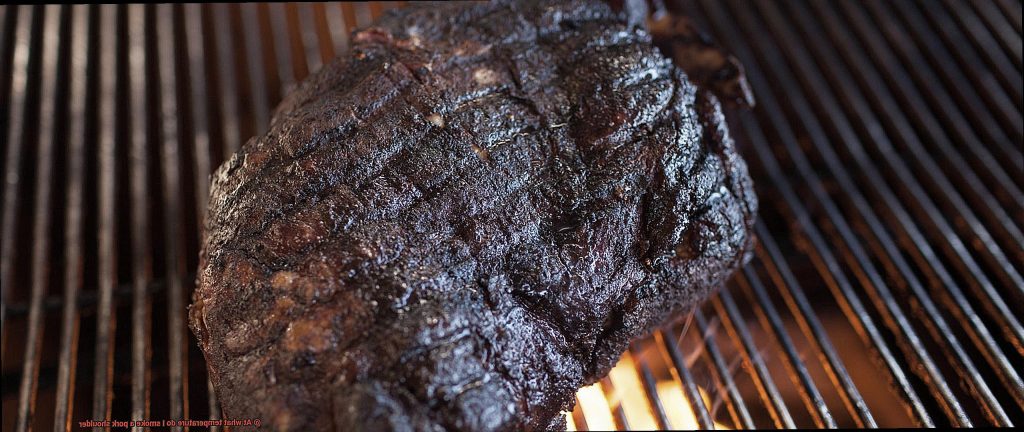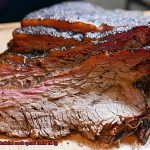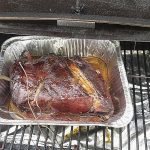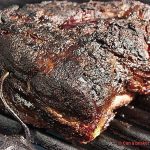Before we get started, there’s one crucial detail you can’t overlook: the right temperature. Trust me, it’s the secret ingredient that’ll make your pork shoulder tender and bursting with flavor.
But don’t worry. Today, I’m going to be your temperature guide. By the end of this post, you’ll have all the knowledge you need to smoke a pork shoulder like a pro. We’ll cover optimal temperatures, the science behind them, and some handy tips to ensure your smoking session is a roaring success.
So, grab a seat, get cozy, and let’s embark on this smokin’ journey together. Get ready to blow away your friends and family with your newfound pork shoulder smoking expertise. Are you excited? Well, you better be. Because we’re about to take a deliciously wild ride.
Contents
What Temperature Should I Smoke a Pork Shoulder?
Embarking on a culinary journey to smoke a pork shoulder requires time, patience, and attention to detail. One of the most critical factors in achieving mouth-watering results is maintaining the ideal temperature throughout the smoking process. In this comprehensive guide, we will delve into the optimal temperature range, important considerations, and essential tips that will help you elevate your pork shoulder smoking game.
The Sweet Spot: Low and Slow Cooking
To unlock tender and flavorful meat, aim for a smoking temperature between 225°F and 250°F (107°C and 121°C). This slow cooking method allows the connective tissues in the pork shoulder to break down gradually, resulting in succulent and juicy meat that melts in your mouth. To maintain consistency, consider investing in a smoker or grill with precise temperature control. Fluctuations in temperature can disrupt the cooking process and lead to unevenly cooked pork.
Ignite with Intensity: The Initial High Heat Phase
Some seasoned pitmasters prefer starting the smoking process at a slightly higher temperature of around 275°F (135°C) for the first couple of hours. This fiery blast kickstarts the flavor development and helps form a tantalizing crust on the meat. After this initial phase, lower the temperature to your desired range for the remainder of the smoking process.
The Patience Game: Slow and Steady Wins
Smoking a pork shoulder is not for those seeking instant gratification. It demands time to achieve perfection. On average, be prepared for a smoking duration of 10 to 14 hours, depending on the size of your pork shoulder and preferred method. Remember, patience is key – trust us, it will be well worth it.
Precision Monitoring: The Internal Temperature Check
To ensure your pork shoulder is cooked to perfection, equip yourself with a reliable meat thermometer. The ideal internal temperature ranges from 195°F to 205°F (90°C to 96°C). For accurate readings, insert the thermometer into the thickest part of the meat, away from any bones.
The Power of Rest: Allow the Juices to Flow
Once your pork shoulder reaches the desired internal temperature, resist the urge to dive right in. Let it rest for at least 30 minutes before slicing or pulling apart. This crucial resting period allows the juices to redistribute throughout the meat, resulting in a final product that is bursting with flavor and moistness.
Embrace Your Inner Pitmaster: Experiment and Personalize
Remember, these guidelines merely serve as a launching pad for your smoking adventure. Every pitmaster has their unique preferences and techniques. Feel free to experiment with different temperatures and cooking times until you discover your perfect smoking technique that will have your family and friends begging for seconds.
Factors to Consider When Smoking a Pork Shoulder
Get ready for a smoky adventure as we dive into the key factors to consider when smoking a pork shoulder. From selecting the right cut of meat to nailing the perfect cooking time and temperature, we’ll guide you through the process of creating a tender and flavorful masterpiece. So grab your apron, settle in, and let’s get grilling.
Cut of Meat:
Choose a pork shoulder, also known as Boston butt or pork butt. Its high fat content and marbling make it perfect for smoking, keeping the meat moist and infusing it with incredible flavor. Opt for bone-in pork shoulder for added depth of taste and tenderness.
Size Matters:
Consider the size of the pork shoulder. Larger cuts require more cooking time to become melt-in-your-mouth tender. Plan ahead and allocate enough time, especially for events or gatherings where patience will be rewarded.
Seasoning Sensations:
Elevate your smoked pork shoulder by selecting a dry rub and seasoning that suits your taste buds. Whether sweet and tangy or spicy, generously coat the meat with your desired blend of herbs, spices, salt, and sugar. Let the flavors meld by refrigerating the seasoned meat for a few hours or overnight.
Equipment Matters:
Choose your smoking equipment wisely as it can make or break your smoking experience. From charcoal smokers to pellet smokers, electric smokers to offset smokers, find one that matches your preferences and level of expertise. And don’t forget a reliable thermometer to monitor cooking temperature.
Low and Slow:
For tender, juicy pulled pork, maintain a consistent temperature of 225-250°F (107-121°C) throughout the cooking process. This slow cooking method allows the collagen in the meat to break down gradually, resulting in succulent perfection.
Patience is Key:
Smoking a pork shoulder requires time and patience. Plan for approximately 1.5 to 2 hours per pound of meat at the recommended cooking temperature. Factors like size, smoker performance, and personal preferences may affect cooking time. Use a meat thermometer to ensure the pork shoulder reaches an internal temperature of 195-205°F (90-96°C) for perfect shredding consistency.
Rest and Relaxation:
Allow the pork shoulder to rest for about 30 minutes to an hour once it reaches its tender destination. This allows the juices to redistribute throughout the meat, resulting in a more flavorful and moist final product.
Different Types of Smokers and Their Temperature Controls
Understanding the different types of smokers and their temperature controls is essential to achieving perfection in your pork shoulder. Let’s dive into the world of smokers and discover how you can create a symphony of flavors and achieve juicy, tender results.
Charcoal Smokers: Embrace the Classic Flavor
For those who crave that traditional, smoky taste, charcoal smokers are the go-to choice. These smokers use charcoal as fuel, imparting a rich flavor to your pork shoulder. Temperature control is an art form achieved by adjusting the airflow through dampers or vents. Open the vents for higher heat or close them to lower the temperature. It’s like conducting an orchestra to create the perfect balance of heat and flavor.
Electric Smokers: Set It and Forget It
Seeking convenience? Electric smokers are a game-changer. Equipped with an electric heating element, these smokers offer consistent heat throughout the cooking process. Temperature control is a breeze with built-in thermostats. Simply set your desired temperature, sit back, and relax while your pork shoulder cooks to perfection.
Pellet Smokers: Versatile and Flavorful
If you’re an adventurous flavor explorer, pellet smokers are your best bet. These smokers use wood pellets made from sawdust to fuel both the fire and add delicious smoky flavors. Temperature control is made easy with digital controllers that allow precise adjustments. It’s like having a personal chef in control of the heat.
Gas Smokers: Quick and Convenient
When time is of the essence, gas smokers come to the rescue. Using propane gas as their fuel source, these smokers provide quick and consistent heat. With built-in temperature gauges or knobs, controlling the cooking temperature becomes effortless. Get ready to grill up that pork shoulder in no time.
Additional Factors:
Apart from the type of smoker, several factors influence temperature control. Consider the size and thickness of your pork shoulder, outdoor weather conditions, and personal preference. These factors will help you fine-tune the temperature for that perfect result.
Preheating Your Smoker
Today, we embark on a journey through the art of preheating your smoker – a crucial step that sets the stage for tender, fall-off-the-bone goodness. Buckle up, because we’re about to elevate your grilling game to new heights.
Let’s start with temperature, the key ingredient to achieving that perfect smoked pork shoulder. The sweet spot for smoking is typically between 225°F and 250°F – a low and slow cooking method that transforms tough connective tissues into melt-in-your-mouth tenderness.
To kickstart this flavor-packed adventure, we need a clean slate. Give your smoker a thorough scrub, removing any residue from previous cooks. No one wants their pork shoulder tainted by last week’s remnants.
Now, it’s time to fuel the fire. Whether you opt for charcoal or wood chips, have them at the ready. Soak wood chips in water for at least 30 minutes before adding them to the smoker – this ensures a slow release of smoky goodness.
Here comes the exhilarating part – igniting that fire. Use a chimney starter or an electric starter to get those coals blazing. Wait until they turn ashy gray before carefully pouring them into the charcoal chamber. For wood chips, sprinkle them over the hot coals or nestle them in a designated chip tray or box.
Seal the deal by closing the lid and adjusting the vents or dampers. These control airflow and are vital for maintaining temperature inside your smoker. Wider vents mean more heat, partially closed means less – it’s like conducting an orchestra of flavor.
Now, patience becomes your greatest ally. Allow your smoker 20-30 minutes to preheat and stabilize at the desired temperature. This is not the time to rush – good things come to those who wait.
During this smoky journey, keep an eagle eye on that temperature. Fluctuations can throw off your cooking time and result in unevenly cooked meat. A reliable thermometer is your trusty sidekick – keep it close and cherish its readings.
And now, my fellow grill enthusiasts, the final challenge awaits – resisting the urge to constantly check on your pork shoulder. Every time you open that smoker, precious heat escapes, extending your cooking time. Trust the process, and let that pork work its magic.
Monitoring the Internal Temperature of the Pork Shoulder
Now, we’re going to dive into the nitty-gritty of smoking a pork shoulder and why it’s absolutely crucial to keep an eye on that internal temperature. So grab your meat thermometers and let’s embark on a flavor-filled journey.
Why is internal temperature so important? Imagine this: you’ve spent hours prepping your pork shoulder, carefully selecting the perfect rub, and lovingly tending to your smoker. The last thing you want is a dry, overcooked piece of meat. By monitoring the internal temperature, you ensure that your pork shoulder reaches the ideal level of tenderness and doneness.
So, what’s the magic number? The sweet spot for smoking a pork shoulder is between 195 to 205 degrees Fahrenheit (90 to 96 degrees Celsius). At this temperature range, the connective tissues in your pork shoulder break down, resulting in that mouthwatering, fall-apart goodness we all crave. To achieve this, invest in a reliable meat thermometer – whether it’s an instant-read or a probe thermometer – and insert it into the thickest part of the meat (avoiding bones) for accurate readings.
But wait, there’s more. To guarantee even cooking throughout your pork shoulder, check the internal temperature in multiple spots. This ensures that every bite is as tender as the next and prevents any unpleasant surprises when slicing into your masterpiece.
Now, slow and steady wins the flavor race. Resist the temptation to crank up the heat and rush the cooking process. Slow and low smoking at a consistent temperature allows for optimal flavor and texture development. Keep an eye on that thermometer and adjust your heat accordingly to maintain a steady temperature throughout.
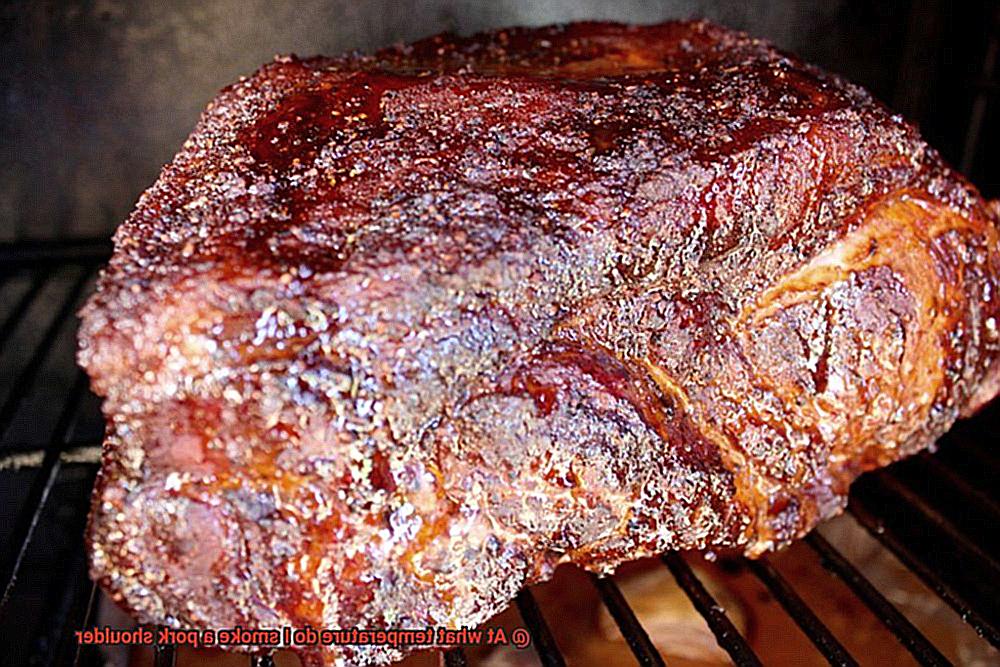
Ah, patience is key. Once your pork shoulder reaches that magical internal temperature, remove it from the smoker and resist digging in right away (I know, it’s hard.). Let it rest for about 20 to 30 minutes. During this time, the residual heat continues to distribute evenly, resulting in a more flavorful and moist end product.
The Texas Crutch Technique
Ready to take your grilling game to the next level? Look no further than the Texas Crutch Technique, a tried-and-true method used by barbecue enthusiasts to achieve tender and juicy pork shoulder. This technique involves wrapping the pork shoulder in foil during the smoking process, resulting in a mouthwatering masterpiece that will have your taste buds dancing with delight.
The purpose of using the Texas Crutch Technique is simple – to prevent the pork shoulder from drying out during the long smoking process. By wrapping the meat in foil, it creates a steamy environment inside, allowing the collagen in the meat to break down more quickly and effectively. The end result? A tender and moist final product that will have your guests begging for seconds.
To use the Texas Crutch Technique, start by smoking the pork shoulder at a low and steady temperature. Aim for around 225°F to 250°F for optimal results. This low and slow cooking method allows the smoke to penetrate the meat and infuse it with delicious flavor.
Once the pork shoulder reaches an internal temperature of around 160°F to 165°F, it’s time to employ the Texas Crutch Technique. Carefully remove the pork shoulder from the smoker and wrap it tightly in heavy-duty aluminum foil. Seal the foil completely to trap in all of those mouthwatering juices.
Return the wrapped pork shoulder to the smoker and continue cooking until it reaches an internal temperature of around 195°F to 205°F. This is known as the “probe tender” stage, where a meat thermometer or probe can easily slide into the meat without resistance. At this point, the collagen has fully broken down, resulting in a tender and succulent pork shoulder that will melt in your mouth.
But how long should you expect this technique to take? As a general guideline, plan for approximately 1.5 to 2 hours per pound of meat. However, it’s important to rely on internal temperature rather than cooking time alone, as every piece of meat is different.
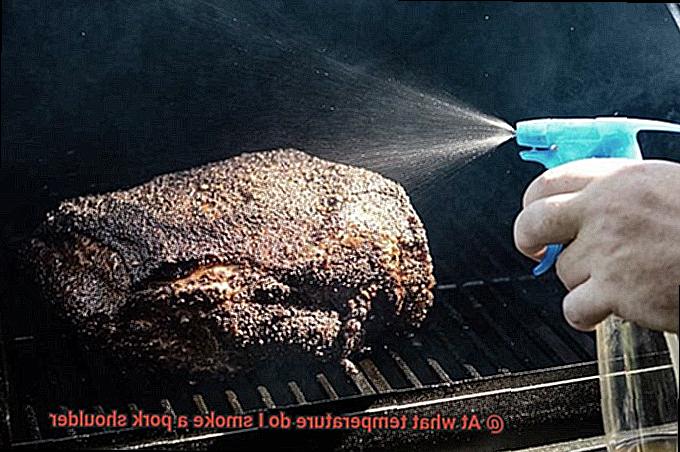
Once the pork shoulder reaches the desired internal temperature and probe tenderness, remove it from the smoker and let it rest for at least 30 minutes. This allows the juices to redistribute throughout the meat, resulting in an even more flavorful and moist final product.
Resting the Meat After Smoking
After hours of careful smoking, the tantalizing aroma of perfectly cooked meat fills the air. Before indulging in that smoky masterpiece, there’s a vital step you mustn’t overlook – resting the meat. In this article, we delve into the benefits of allowing your smoked meat to rest, unlocking its full potential and ensuring a truly unforgettable dining experience.
Juicy Bliss:
As meat slowly smokes, its natural juices rise to the surface. Resting the meat allows these succulent liquids to redistribute evenly throughout the entire cut. This ensures that each mouthwatering bite is infused with moisture and bursting with unparalleled flavor. Think of it as a moment for the meat to marinate in its own delectable essence.
Meltingly Tender Texture:
Smoking tenderizes even the toughest cuts of meat, but resting takes it a step further. During this crucial period, the muscle fibers relax and unwind, resulting in an exquisitely melt-in-your-mouth texture. It’s like giving your meat a well-deserved massage after enduring the intense heat of the smoker.
Flavor Fusion:
While resting, the flavors from rubs and smoke harmonize and intensify, creating a symphony of taste that dances on your palate. It’s like hosting a flavor party within that glorious piece of meat. The end result? Each bite becomes an explosion of complex and perfectly balanced flavors, leaving you craving more.
Moisture Magic:
Resting not only enhances flavor and tenderness but also prevents moisture loss. Any excess moisture on the surface of the meat is reabsorbed during this time, ensuring that when you slice into it, each succulent piece remains juicy and luscious instead of drying out.
The Art of Tenting:
To properly rest your smoked meat, transfer it to a cutting board or platter and gently tent it with aluminum foil. This technique allows the meat to retain its warmth while still allowing for a gentle circulation of air, keeping it at the perfect temperature for serving.
Patience, the Ultimate Reward:
Now comes the most challenging part – waiting. Although it may be tempting to dive right in and savor that smoky goodness immediately, resist. Give your meat at least 30 minutes to an hour to rest. Trust me; the rewards are well worth the patience.
4-G7L0zIkjs” >
Conclusion
When it comes to smoking a pork shoulder, the temperature you choose is crucial.
It’s not just about cooking the meat; it’s about creating that perfect balance of tenderness and flavor. So, what temperature should you aim for?
Well, the sweet spot lies between 225°F and 250°F. This low and slow method allows the fat to render slowly, resulting in juicy, melt-in-your-mouth goodness.
But don’t rush it. Patience is key here. At this point, you’ll achieve that coveted fall-apart texture that will make your taste buds sing with delight.

